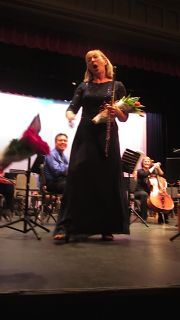|
Symphony
SRS SEASON ENDS WITH RESOUNDING TA-TA-TA-BANG
by Terry McNeill
Sunday, June 1, 2025
Symphony
YOUTHFUL VIRTUOSITY ON DISPLAY AT USO'S MAY CONCERTS
by Peter Lert
Saturday, May 17, 2025
Symphony
MYSTICAL PLANETS AND LIVELY GERSHWIN ORTIZ AT FINAL SRS CONCERT
by Peter Lert
Sunday, May 4, 2025
Symphony
VSO'S CONCERT MUSIC OF TIME, MUSIC OF PLACE
by Peter Lert
Sunday, April 27, 2025
Choral and Vocal
VOCAL ELEGANCE AND FIRE AT THE 222'S RECITAL APRIL 26
by Pamela Hicks Gailey
Saturday, April 26, 2025
CANTIAMO SONOMA SINGS AN INSPIRED GOOD FRIDAY MOZART REQUIEM CONCERT
by Pamela Hicks Gailey
Friday, April 18, 2025
DRAMATIC SHOSTAKOVICH SYMPHONY CLOSES PHILHARMONIC'S 25TH SEASON
by Terry McNeill
Sunday, April 13, 2025
LARGE COLLEGE OF MARIN AUDIENCE GREETS STOPHER ARTISTRY
by Terry McNeill
Saturday, April 5, 2025
Chamber
FRISSON DELIVERS SHIVERS OF DELIGHT
by Abby Wasserman
Sunday, March 30, 2025
OLD AND MOSTLY NEW IN SRS MARCH CONCERT IN WEILL
by Peter Lert
Saturday, March 22, 2025
|
 |
 K. Reynolds Receiving Flowers March 28 |
HARMONIC CONVERGENCE IN PHILHARMONIC CONCERT
by Terry McNeill
Saturday, March 28, 2015
Concluding a stellar season March 28 in the Santa Rosa High School Auditorium the Sonoma County Philharmonic played a concert rich in orchestral symmetry, mixed with a piquant flute concerto.
The symmetry began with the afternoon’s initial work, Carlos Escalante Macaya’s five-part “Ineluctble…El Tiempo.” Composed as a dance suite, the work spanned 30 minutes had a sensuous mix of color, especially from the winds, harp (Dan Levitan) and a six-person percussion section. Led by timpanist Anthony Blake, the sextet included Joseph Long (snare drum and others); Al Sinerco (glockenspiel); Jocelyn McCord (vibraphone); Walt Bodley (bass and tom tom drums) and Mary Greenberg (blocks and shakers).
Mr. Escalante, whose clarinet concerto was played in 2013 by the SCP, has a penchant for florid orchestration that had touches of minimalism (Reich’s “Music for 18 Instruments”) juxtaposed with lively themes sweetened by flute solos. The lovely Bourée had a beguiling pensive character, and the often tricky rhythms were deftly managed by conductor Norman Gamboa. There were several intense climaxes punctuated by the playing of three trombones and a solo by bassoonist Miranda Kincaid, with elegant oboe playing from Chris Crieve. The conductor shaped everything well and seldom looked at the score.
Prokofiev’s second Suite from the ballet “Romeo and Juliet,” Op. 64, concluded the first half. In seven parts the music from the mid 1930s was played with all the composer’s trademarks of the time: lush harmonies, brilliant brass, long thematic lines and limpid instrumental duos with solo violinist Pam Osuka.. The short references to Shostakovich’s Fourth Symphony from 1936 were underlined in a duet from bassoonist Miranda Kincaid and flutist Emily Reynolds, and allusions to Respighi’s “Pines of Rome” were in this princely music. Mr. Gamboa directed with mastery the shimmering fabric and potent climaxes of the long Suite that never felt long.
In the finale (Romeo and Juliet’s Grave) tenor saxophone Ken Ward and celeste player Alice Chan were standouts. There was a sad texture to this section, punctuated by a piccolo solo in the long decrescendo at the end.
Following intermission Liebermann’s Flute Concerto, Op. 39, was played, and is a popular (for a flute concerto) 1992 work that featured Sonoma County virtuoso Kathleen Lane Reynolds. Some might say “local girl makes good” but such a comment is inane, as Ms. Reynolds is a mature musician that has played splendidly for years with the Santa Rosa Symphony. The choice of the Liebermann was a savvy program selection as the work is harmonically grateful and made the most of the soloist’s formidable interpretative command.
Parts of the three-movement Concerto reflect movie music, not a bad thing from masters such as Korngold, Copland and Liebermann. Ms. Reynolds played the high-register runs and surprise turns in the Moderato with easy aplomb, giving a feeling of vistas opening. There were captivating and balanced duets between the solo flute and the orchestra, and Mr. Gamboa's hand was light when it needed to be. In the lyrical Adagio connections with the “Romeo and Juliet” Suite were evident in modulations, generous resonance and the Ms. Reynolds’ sound that oddly approximated the oboe at times. This savory playing had perfect breath control, leading up to meditative and long-held final note.
The concluding racehorse Presto featured the soloist’s quick upward phrases and accurate octave skips. I have heard the movement played faster with mastery equal to that of Ms. Reynolds, but the acceleration to the end was imposing and brought the audience of 400 to their feet with loud applause.
Of course bundles of flowers were quickly brought to Ms. Reynolds, some by Santa Rosa Symphony colleagues, and was indication of the the esteem with which they hold her artistry.
|

